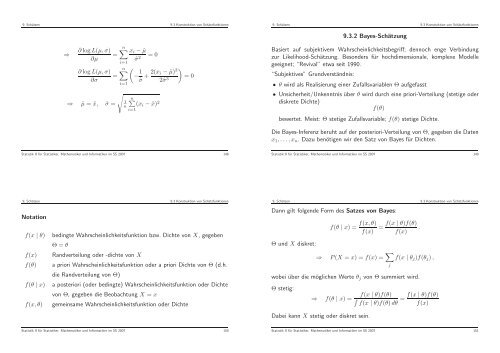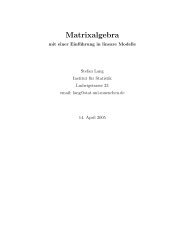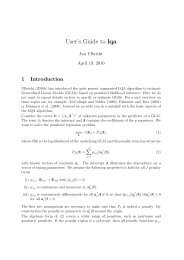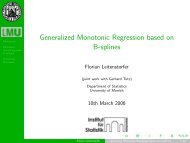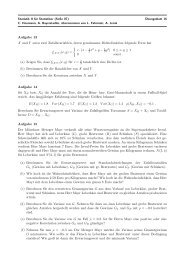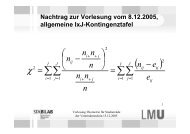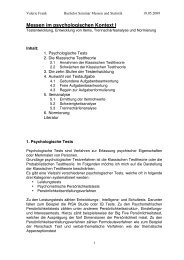Statistik II für Statistiker, Mathematiker und Informatiker (SS ... - LMU
Statistik II für Statistiker, Mathematiker und Informatiker (SS ... - LMU
Statistik II für Statistiker, Mathematiker und Informatiker (SS ... - LMU
Sie wollen auch ein ePaper? Erhöhen Sie die Reichweite Ihrer Titel.
YUMPU macht aus Druck-PDFs automatisch weboptimierte ePaper, die Google liebt.
9. Schätzen 9.3 Konstruktion von Schätzfunktionen<br />
9. Schätzen 9.3 Konstruktion von Schätzfunktionen<br />
9.3.2 Bayes-Schätzung<br />
⇒<br />
∂ log L(µ,σ)<br />
=<br />
∂µ<br />
∂ log L(µ,σ)<br />
∂σ<br />
=<br />
⇒ ˆµ = ¯x, ˆσ =<br />
n∑ x i − ˆµ<br />
= 0<br />
ˆσ 2<br />
n∑<br />
(− 1ˆσ + 2(x i − ˆµ) 2 )<br />
= 0<br />
2ˆσ 3<br />
i=1<br />
i=1<br />
√<br />
n∑<br />
(x i − ¯x) 2<br />
1<br />
n<br />
i=1<br />
Basiert auf subjektivem Wahrscheinlichkeitsbegriff; dennoch enge Verbindung<br />
zur Likelihood-Schätzung. Besonders <strong>für</strong> hochdimensionale, komplexe Modelle<br />
geeignet; “Revival” etwa seit 1990.<br />
“Subjektives” Gr<strong>und</strong>verständnis:<br />
• θ wird als Realisierung einer Zufallsvariablen Θ aufgefasst<br />
• Unsicherheit/Unkenntnis über θ wird durch eine priori-Verteilung (stetige oder<br />
diskrete Dichte)<br />
f(θ)<br />
bewertet. Meist: Θ stetige Zufallsvariable; f(θ) stetige Dichte.<br />
Die Bayes-Inferenz beruht auf der posteriori-Verteilung von Θ, gegeben die Daten<br />
x 1 , ...,x n . Dazu benötigen wir den Satz von Bayes <strong>für</strong> Dichten.<br />
<strong>Statistik</strong> <strong>II</strong> <strong>für</strong> <strong>Statistik</strong>er, <strong>Mathematiker</strong> <strong>und</strong> <strong>Informatiker</strong> im <strong>SS</strong> 2007 148<br />
<strong>Statistik</strong> <strong>II</strong> <strong>für</strong> <strong>Statistik</strong>er, <strong>Mathematiker</strong> <strong>und</strong> <strong>Informatiker</strong> im <strong>SS</strong> 2007 149<br />
9. Schätzen 9.3 Konstruktion von Schätzfunktionen<br />
Notation<br />
f(x | θ) bedingte Wahrscheinlichkeitsfunktion bzw. Dichte von X, gegeben<br />
Θ = θ<br />
f(x) Randverteilung oder -dichte von X<br />
f(θ) a priori Wahrscheinlichkeitsfunktion oder a priori Dichte von Θ (d.h.<br />
die Randverteilung von Θ)<br />
f(θ | x) a posteriori (oder bedingte) Wahrscheinlichkeitsfunktion oder Dichte<br />
von Θ, gegeben die Beobachtung X = x<br />
f(x,θ) gemeinsame Wahrscheinlichkeitsfunktion oder Dichte<br />
9. Schätzen 9.3 Konstruktion von Schätzfunktionen<br />
Dann gilt folgende Form des Satzes von Bayes:<br />
Θ <strong>und</strong> X diskret:<br />
⇒<br />
f(θ | x) =<br />
f(x, θ)<br />
f(x)<br />
=<br />
P(X = x) = f(x) = ∑ j<br />
f(x | θ)f(θ)<br />
.<br />
f(x)<br />
f(x | θ j )f(θ j ) ,<br />
wobei über die möglichen Werte θ j von Θ summiert wird.<br />
Θ stetig:<br />
⇒ f(θ | x) =<br />
Dabei kann X stetig oder diskret sein.<br />
f(x | θ)f(θ) f(x | θ)f(θ)<br />
∫ = f(x | θ)f(θ)dθ f(x)<br />
<strong>Statistik</strong> <strong>II</strong> <strong>für</strong> <strong>Statistik</strong>er, <strong>Mathematiker</strong> <strong>und</strong> <strong>Informatiker</strong> im <strong>SS</strong> 2007 150<br />
<strong>Statistik</strong> <strong>II</strong> <strong>für</strong> <strong>Statistik</strong>er, <strong>Mathematiker</strong> <strong>und</strong> <strong>Informatiker</strong> im <strong>SS</strong> 2007 151


